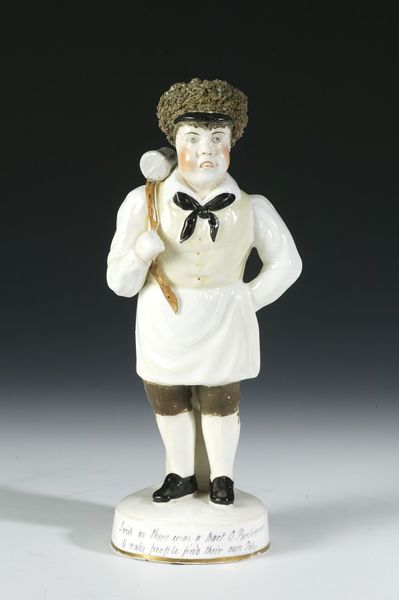I’d expected to come across a head of a china figure at some point
but didn’t consider it could be a torso. I still do wonder why on earth I
picked this broken old thing up. It’s a specimen of things I could never stand -
china figurines, but things always seem rather more interesting when you ease
them out of the mud and want to figure out what they are and the story they
have to tell.
Press moulds were used, the worker’s finger print can be seen clearly inside my find, left as they pressed the clay into the mould. Earlier figures were made with back and front moulds with features and colour all the way round. Enamel colours were painted onto the glazed figures by hand, fixed by another firing at lower temperatures, occasionally gilt was then added before a final firing.
After 1840 figures tended to be slip caste in one mould and flat backed so they could sit flush with the wall atop mantelpieces.
The emphasis was on cost. The figurines were churned out cheaply and quickly using child and women’s labour for 12 hours a day 6 days a week. There were dozens of potteries producing them. Virtually no one bothered to imprint maker’s marks. Many potteries went out of business in this highly competitive market and sold on their moulds and stock. Therefore it’s rare you can trace particular figures to specific potteries.
What’s interesting about the figurines is the insight they provide into popular taste. They offered the middle classes an affordable alternative to the expensive porcelain figures produced by the Meissen pottery in Germany and Chelsea and Derby factories in England.
It seems the Victorians were particularly mad about these figurines. Perhaps more people had greater disposable income as the industrial revolution kicked in and production costs declined so they were within reach.
The early Georgian figurines tended to represent biblical or classical figures or romantic representations of rural life.
In Victorian times, the celebrities, venerated and events of their day were quickly caste. Likenesses were copied from prints. Purchase and display was a way of communicating your erudition, cultivation, humour and how with it you were, perhaps equivalent to the facebook likes, shares and retweets of today.
Actors and comedians seem to have been their celebrities, almost all of whom are forgotten now. Below is John Liston, apparently one of the greatest comedians of all time, he was the first comic actor to command a higher salary than a tragedian, earning the vast sum of £60-£100 a week in 1820.
 |
| John Liston Playing Sam Swipes at the Haymarket 1820 (V&A) |
 |
| Bust of John Wesley (Madelena.com) |
 |
| Death of the Lion Queen 1850 (madelena.com) |
It’s not evident to me what period my find is from, she was found on the Georgian mudbank amid shards of white salt glazed plates and early Worcester Porcelain, so I suspect she’s one of the early Georgian types, a hunch backed up by her roundness and similarity to the figures below produced around 1790.
(thank you to V&A and Madelena Antiques for all the information on their websites which helped me piece this together).




I think that should be "longton" not Loughton.
ReplyDeleteYour find is not typical of Staffordshire and could also be Yorkshire,Scottish,German,etc,etc
(donkey)
Thanks Donkey, yes I had meant to say that these figures were also produced elsewhere,- so sounds like she may still hold some mystery. Julia
ReplyDeleteDear Julia,
ReplyDeleteI am doing a project about mudlarking. How could I contact you and send a couple of questions about your amazing blog?
Natalia
Dear Julia,
ReplyDeleteReally interesting, thank you. You are correct in thinking this is an Early Staffordshire pottery figure. Also known as 'Pealrware'.
Thank you for the mention.
Good luck with future hunting.
Ben Tulk
madelena.com
On what basis does Madelena ascribe "pearlware" to your find?
ReplyDeleteThe glaze does not show any signs of blueing.
And the broken parts don't show any sign of the blackening that pearlware usually does.
Interestingly the front panel of dress (with the dots) does looks like pearlware and is more blue than perhaps you would think when looking at the photo above - I wonder who is right? Julia
Delete